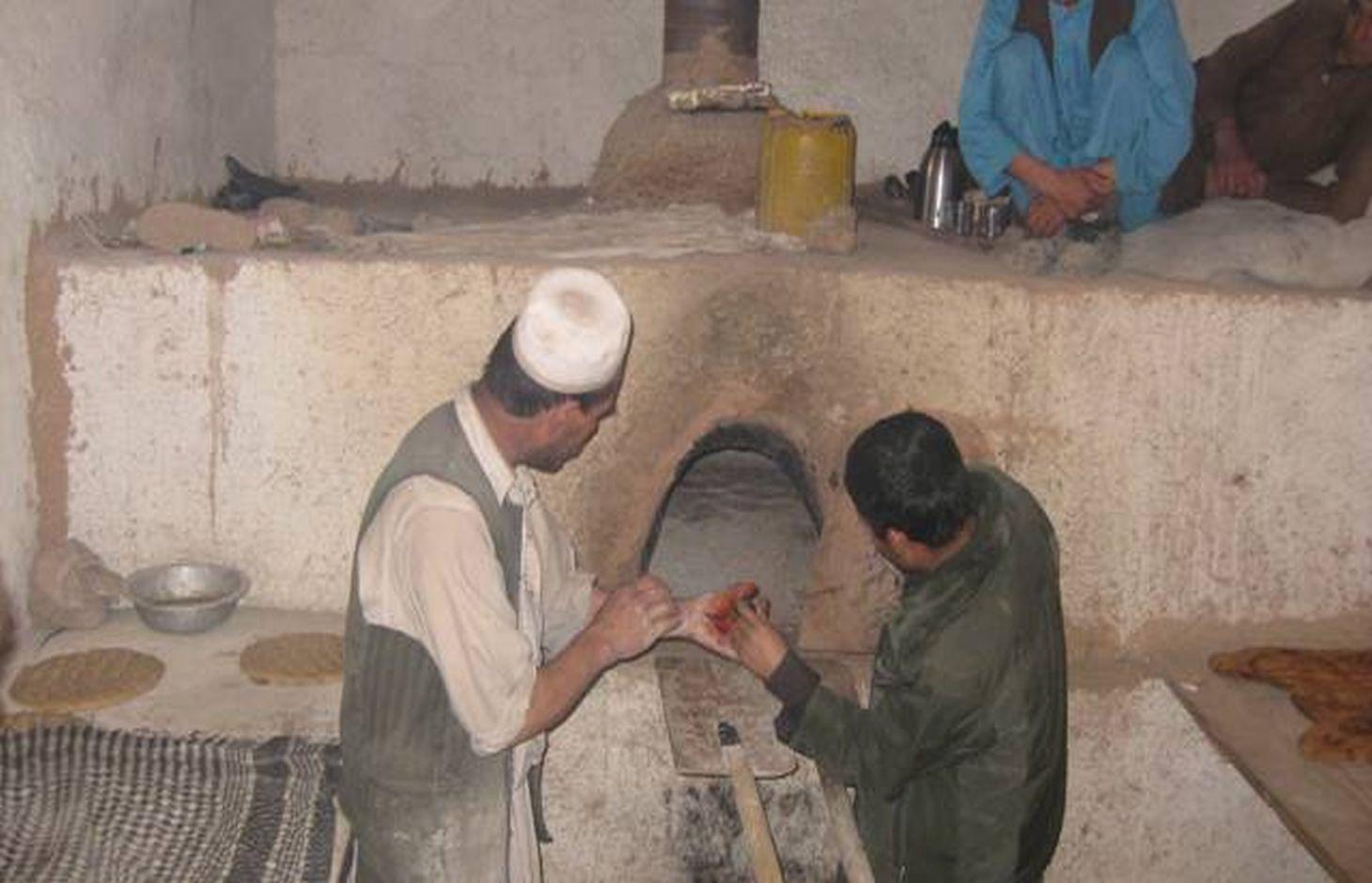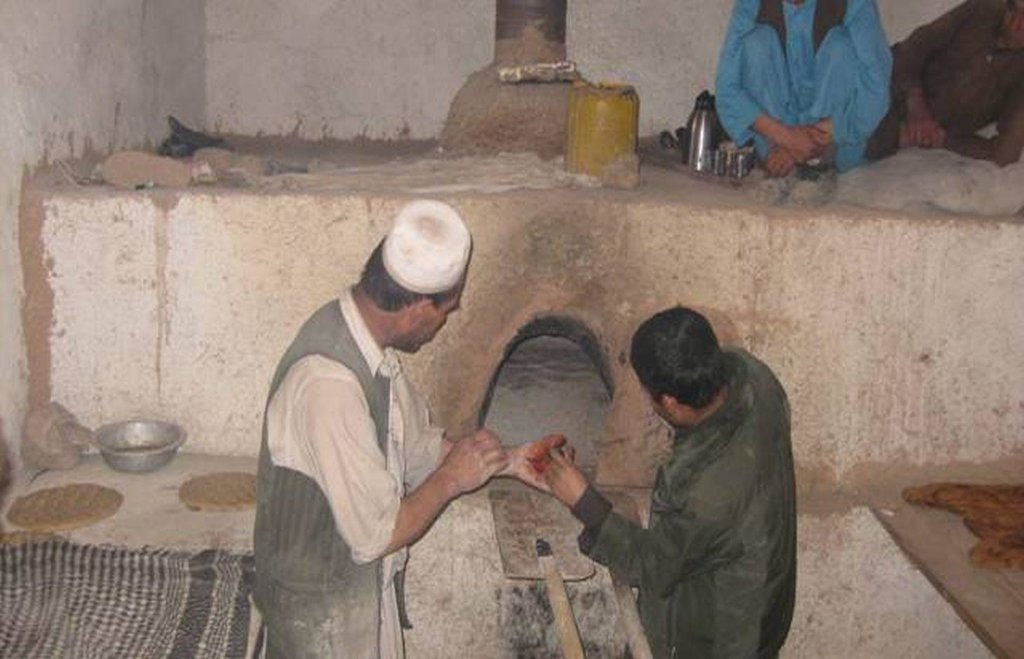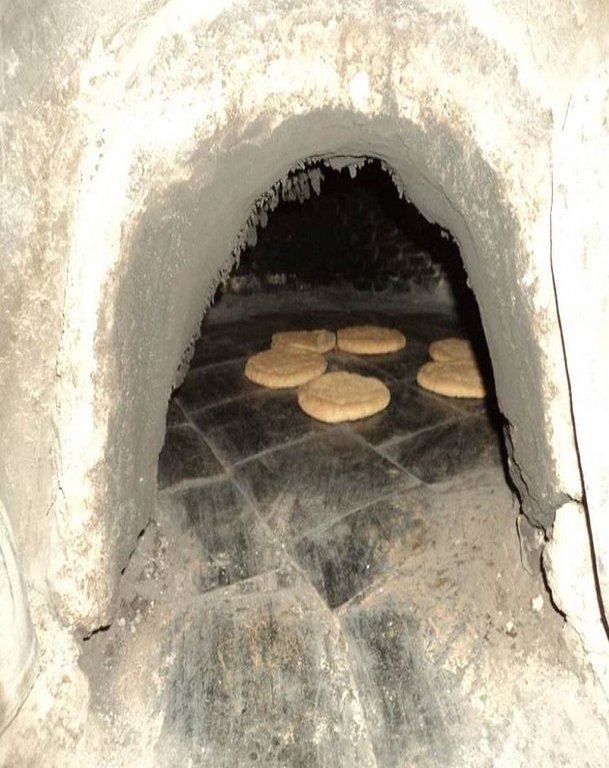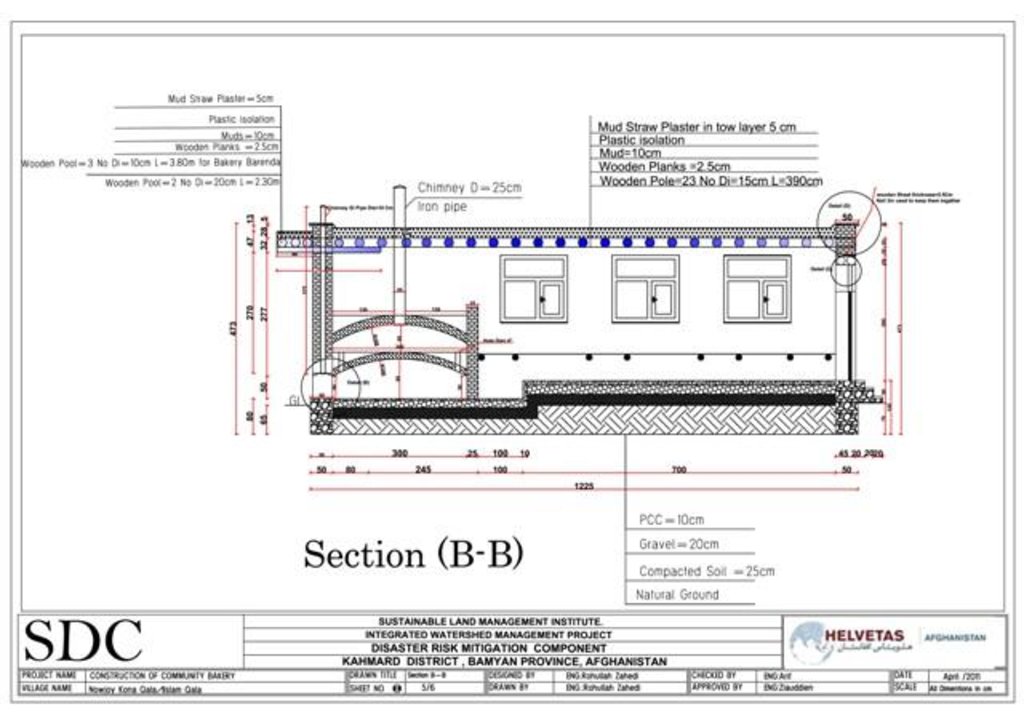Community bakery [أفغانستان]
- تاريخ الإنشاء:
- تحديث:
- جامع المعلومات: Aqila Haidery
- المحرر: –
- المراجعون: Deborah Niggli, Joana Eichenberger
Dash Nanboe (Dari)
technologies_1718 - أفغانستان
عرض الأقسام
توسيع الكل طي الكل1. معلومات عامة
1.2 تفاصيل الاتصال بالأشخاص الرئيسيين لمصدر المعلومات والمؤسسات المشاركة في تقييم وتوثيق التقنية
متخصص في الإدارة المستدامة للأراضي:
Homayoun Ashraf
HELVETAS Swiss Intercooperation
أفغانستان
متخصص في الإدارة المستدامة للأراضي:
Ahmad Ali Sediqi
HELVETAS Swiss Intercooperation
أفغانستان
اسم المؤسسة (المؤسسات) التي سهلت توثيق/تقييم التقنية (إذا كان ذلك على صلة)
HELVETAS (Swiss Intercooperation)1.3 الشروط المتعلقة باستخدام البيانات الموثقة من خلال WOCAT
يوافق جامع المعلومات والشخص (لاشخاص) الرئيسي لمصدر المعلومات على الشروط المتعلقة باستخدام البيانات الموثقة من خلال WOCAT:
نعم
1.4 إعلان بشأن استدامة التقنية الموصوفة
هل التقنية الموصوفة هنا تمثل مشكلة فيما يتعلق بتدهور الأراضي، بحيث لا يمكن إعلانها تقنية مستدامة لإدارة الأراضي؟:
كلا
2. وصف تقنيةالإدارة المستدامي للأراضي
2.1 وصف مختصر للتقنية
تعريف التقنية:
A sustainable option for bread baking and reducing shrub consumption
2.2 وصف تفصيلي للتقنية
الوصف:
Thirty six community bakeries were constructed in Kahmard from 2009-2012 for reducing shrub consumption. Rural communities normally bake bread at home using tandoors made from clay and fired by shrubs, wood and coal. Bread baking is a demanding task. Men and boys climb mountains to collect shrubs, putting themselves at risk, and women spend 1-2 hours/day for preparing dough, firing the oven and baking bread. Shrub cutting causes upland degradation leading to flash floods in the valleys.
In Saighan, district adjoining Kahmard, a survey showed that one household uses 81 donkey load shrubs annually, and minimum 50 donkey loads are used for baking bread. Kahmard has a similar situation. To address this, HELVETAS Swiss Intercooperation is supporting an integrated watershed management in Kahmard since 2008 with support from the Swiss Re and Swiss Agency for Development and Cooperation (SDC). The approach comprises other technological and organisational measures where structural and vegetative are applied, combined with grazing and shrub cutting control. To complement re-greening efforts, energy efficient community bakeries were promoted.
Households using community bakeries reported a decrease in shrub consumption by 50-80%, which contributes to greener watersheds. The other benefits include more time for women, boys and girls for other preferred activities, like attending school, literacy classes, vocational trainings, embroidery, etc. Families also save money (minimum US$ 10/month) as they have to purchase less shrubs for baking purpose. In Kahmard, one donkey load shrub costs about US$ 6. Bakers, assistant bakers, masons and workers are employed and bakeries serve as a place for social networking. By contributing to greener watersheds, the bakeries help to reduce flash flood risks. In recent months, running the bakeries has become a challenge as the coal mines in Kahmard have been contracted to a Chinese firm. As a consequence, people are not getting coal easily. Due to coal shortages, several bakeries have stopped functioning. People are looking towards the government authorities to solve this issue as soon as possible. Many households have gone back to shrub cutting and a community assets with proven benefits for the people but environment remains underutilized.
The participating community development councils or CDCs allocate land for bakery. One bakery costs about US$ 4640, with 25% community contribution during construction. It takes about 5 weeks for constructing one bakery if there are no obstacles. About US$ 7300/year is spent on operation and maintenance by the people. One baker and 1-2 assistants are employed for daily bakery operations. The dash or oven is prepared from a mixture of clay and sheep hair and fired by coal. About 1-3 bags are required per day. If mosaic tiles are used, about 1 bag per day is used for heating. The factors influencing the success of community bakeries include access to coal, good quality and low price of coal, on time payment and proper management of bakery funds. The clients bring dough from home and pay about US$ 0.042 (2 Afghani) per bread to the baker or about US$ 6.6/month.
Community bakeries were constructed in the Kahmard district in the valley bottoms where the people reside. The land for community bakeries normally belongs to the community, but where suitable common land is not available, individuals have also donated their private lands for the common cause.
Community bakeries are located at an altitude of about 1700-1800 m above mean sea level. The district receives up to 400 mm rainfall in a good year. In the valley bottom, there are crop growing seasons, the main is from March to July. The land users rely mainly on agriculture for their livelihoods as employment opportunities in the district are very few. Kahmard district has a population density of about 30 person/sq. km. About 50% of the rural population in Kahmard falls under poor category, 40% are medium rich and 10% rich.
2.3 صور التقنية
2.5 البلد/المنطقة/المواقع التي تم تنفيذ التقنية فيها والتي يغطيها هذا التقييم
البلد:
أفغانستان
المنطقة/الولاية/المحافظة:
Bamyan Province
مزيد من التفاصيل حول الموقع:
Kahmard district
حدد انتشار التقنية:
- منتشرة بالتساوي على مساحة
إذا كانت المساحة الدقيقة غير معروفة، فيرجى الإشارة إلى المنطقة التقريبية المغطاة:
- < 0.1 كم2 (10 هكتار)
التعليقات:
Each bakery has an area of about 58 sq. m, and 25 bakeries have been constructed so far in Kahmard district with HELVETAS Swiss Intercooperation support and financial contributions from the Swiss Agency for Development and Cooperation (SDC).
Map
×2.6 تاريخ التنفيذ
في حالة عدم معرفة السنة بالتحديد، يرجى الإشارة إلى التاريخ التقريبي:
- منذ أقل من 10 سنوات (مؤخرًا)
2.7 إدخال التقنية
حدد كيف تم إدخال التقنية:
- من خلال المشاريع/ التدخلات الخارجية
التعليقات (نوع المشروع، الخ):
The first community bakery in Kahmard district was constructed in 2009 with HELVETAS Swiss Intercooperation support. Since then, 25 bakeries have been constructed as a complementary watershed management technology.
3. تصنيف تقنية الإدارة المستدامي للأراضي
3.2 نوع (أنواع) استخدام الأراضي الحالية حيث يتم تطبيق التقنية

المستوطنات والبنية التحتية
- Community bakeries

أرض غير منتجة
حدد:
Wastelands, deserts, glaciers, swamps, recreation areas, etc before Technology, settlements, infrastructure networks afterwards.
التعليقات:
Major land use problems (compiler’s opinion): Severe flash floods due to degradation of upland watersheds as a result of overgrazing, shrub uprooting, ploughing and recurring droughts. There is a lack of organizational capacities for sustainable management of land and water resources.
Major land use problems (land users’ perception): Severe flash floods due to watershed degradation resulting in destruction of property and life. Lack of knowledge about disaster risk mitigation. Lack of alternatives to fuel wood, especially for bread baking and house warming.
Future (final) land use (after implementation of SLM Technology): Other: Os: Settlements, infrastructure networks
Constraints of settlement / urban: Some areas are not fully utilized. Some are vulnerable to flash floods.
Number of growing seasons per year: 2
Longest growing period in days: 150, Longest growing period from month to month: March to July, Second longest growing period in days: 90, Second longest growing period from month to month: August to October
3.3 هل تغير استخدام الأراضي نتيجة لتنفيذ التقنية؟

أرض غير منتجة
حدد:
Wastelands, deserts, glaciers, swamps, recreation areas, etc before Technology, settlements, infrastructure networks afterwards.
3.5 مجموعةالإدارة المستدامة للأراضي التي تنتمي إليها هذه التقنية
- الرعي وإدارة المراعي
- تحسين الغطاء الأرضي/النباتي
3.6 التدابير التقنية في مجال إلادارة المستدامة للأراضي

التدابير البنيوية
- S11: غير ذلك
3.7 الأنواع الرئيسية من تدهور الأراضي التي تناولتها التقنية

تآكل التربة بالمياه
- الوزن(Wt): فقدان التربة السطحية/تآكل السطح
- (Wg):الانجراف الخلجاني/ الخلجان

التدهور البيولوجي
- (Bc): تناقص الغطاء النباتي
التعليقات:
Main causes of degradation: over-exploitation of vegetation for domestic use (extraction of shrubs for fuelwood), overgrazing (Overgrazing by sheep and goats), disturbance of water cycle (infiltration / runoff) (Due to biological degradation), droughts (Recurring droughts slow down vegetation recovery), land tenure (If it was private land, degradation extent would have been much less), governance / institutional (There is no legal and institutional set up for community based natural resource management)
Secondary causes of degradation: deforestation / removal of natural vegetation (incl. forest fires) (Removal of Juniper trees during war period), other natural causes (avalanches, volcanic eruptions, mud flows, highly susceptible natural resources, extreme topography, etc.) specify (Some grazed areas are very steep), population pressure (Due to increasing population, there is increasing pressure on natural resources), poverty / wealth (People depend on livestock. There is lack of off-farm employment opportunities), war and conflicts (During war, traditional NRM systems also collapsed)
3.8 منع أو حد أو عكس تدهور الأراضي
تحديد هدف التقنية فيما يتعلق بتدهور الأراضي:
- الحد من تدهور الأراضي
- اصلاح/إعادة تأهيل الأراضي المتدهورة بشدة
4. المواصفات الفنية، وأنشطة التنفيذ، والمدخلات، والتكاليف
4.1 الرسم الفني للتقنية
المواصفات الفنية (المتعلقة بالرسم الفني):
A detailed technical drawing (long section) of a community bakery in Kahmard district supported by HELVETAS Swiss Intercoop-eration with the dome shaped oven or dash.
Location: Nowjoy Kona Qala. Kahmard district/Bamyan province
Date: 04/2009
Technical knowledge required for field staff / advisors: moderate (The community bakery was designed by Engineers of HELVETAS Swiss Intercooperation)
Technical knowledge required for land users: high (Construction of dash requires high technical knowledge. There are however some very skilled people in the community who know the art of making dash.)
Main technical functions: improvement of ground cover, increase of infiltration, Reduces people's dependency on shrubs, which are extracted from the upland watersheds
Structural measure: Community Bakery
Height of bunds/banks/others (m): 4.75
Width of bunds/banks/others (m): 7.45
Length of bunds/banks/others (m): 12.5
Construction material (earth): Soil/clay/sand
Construction material (stone): stones for foundation/bricks (sun dried)
Construction material (wood): Poles for roof beams, doors, windows
Construction material (concrete): cement, gypsum
Construction material (other): hair for dash
المؤلف:
Eng. Rohullah Zahedi, HELVETAS Swiss Intercooperation, Afghanistan
4.2 معلومات عامة بخصوص حساب المدخلات والتكاليف
عملة أخرى/ عملة وطنية (حدد):
Afghani
إذا كان ذا صلة، وضح سعر الصرف من الدولار الأمريكي إلى العملة المحلية (على سبيل المثال، 1 دولار أمريكي = 79.9 ريال برازيلي): 1 دولار أمريكي =:
50,0
اذكر متوسط تكلفة أجر العمالة المستأجرة في اليوم الواحد:
5.00
4.3 أنشطة التأسيس
| النشاط | التوقيت (الموسم) | |
|---|---|---|
| 1. | Construction of community bakery as per technical design and based on feasibility study | Five months |
4.4 التكاليف والمدخلات اللازمة للتأسيس
| تحديد المدخلات | الوحدة | الكمية | التكاليف لكل وحدة | إجمالي التكاليف لكل مدخل | % من التكاليف التي يتحملها مستخدمو الأراضي | |
|---|---|---|---|---|---|---|
| العمالة | 1,0 | 1223,0 | 1223,0 | 10,0 | ||
| معدات | Tools | 1,0 | 60,0 | 60,0 | 100,0 | |
| مواد البناء | Sand, soil, cement, gypsum, br | 1,0 | 3356,0 | 3356,0 | 30,0 | |
| إجمالي تكاليف إنشاء التقنية | 4639,0 | |||||
| إجمالي تكاليف إنشاء التقنية بالدولار الأمريكي | 92,78 | |||||
التعليقات:
Duration of establishment phase: 1.5 month(s)
4.5 الصيانة/الأنشطة المتكررة
| النشاط | التوقيت/الوتيرة | |
|---|---|---|
| 1. | Bakery operation (Baker and Assistant Baker salaries) | Year round |
| 2. | Roof plastering with clay and straw | Once before winter |
| 3. | Baking bread | Year round |
| 4. | Dash firing and heating | year round |
| 5. | Fire ignition | Year round |
4.6 التكاليف والمدخلات اللازمة للصيانة/للأنشطة المتكررة (سنويًا)
| تحديد المدخلات | الوحدة | الكمية | التكاليف لكل وحدة | إجمالي التكاليف لكل مدخل | % من التكاليف التي يتحملها مستخدمو الأراضي | |
|---|---|---|---|---|---|---|
| العمالة | 1,0 | 3600,0 | 3600,0 | 100,0 | ||
| مواد البناء | Roof plastering mud and straw | 1,0 | 38,5 | 38,5 | 100,0 | |
| مواد البناء | Coal | 1,0 | 3650,0 | 3650,0 | 100,0 | |
| مواد البناء | Tyre | 1,0 | 300,0 | 300,0 | 100,0 | |
| مواد البناء | Dash shovel | 1,0 | 10,0 | 10,0 | 100,0 | |
| إجمالي تكاليف صيانة التقنية | 7598,5 | |||||
| إجمالي تكاليف صيانة التقنية بالدولار الأمريكي | 151,97 | |||||
التعليقات:
Machinery/ tools: Sand, Soil, cement, gypsum, bricks, stones, gravel, straw, plastic, clay, hair, wooden door, timber for beams, glass, paint, gutter pipes. Ventilation pipes
The costs in 2.6.1. relate to the construction, operation and maintenance of one community bakery. The estimates are based on the Bills of Quantity prepared in 2009.
4.7 أهم العوامل المؤثرة على التكاليف
قدم وصفا لأهم العوامل التي تؤثر على التكاليف:
Most of the expenses for construction work is on equipment and materials like shovels, pick axe, wheel barrow, wooden doors, timber beams, window, concrete bricks, and sun dried bricks. In terms of recurrent costs, most spending is on coal and on the salaries of the baker and assistant bakers.
5. البيئة الطبيعية والبشرية
5.1 المناخ
هطول الأمطار السنوي
- < 250 مم
- 251- 500 ملم
- 501 - 750ملم
- 1,000-751 ملم
- 1,500-1,100 ملم
- 2,000-1,500 ملم
- 3,000-2,001 ملم
- 4,000-3,100 ملم
- > 4000 ملم
المنطقة المناخية الزراعية
- شبه قاحلة
Thermal climate class: temperate. The minimum temperature in Kahmard district can be up to -70°C.
5.2 طوبوغرافيا
متوسط الانحدارات:
- مسطح (0-2%)
- بسيط (3-5%)
- معتدل (6-10%)
- متدحرج (11-15%)
- تلال (16-30%)
- شديدة الانحدار(31-60%)
- فائقة الانحدار (>60%)
التضاريس:
- هضاب/سهول
- أثلام مرتفعة
- المنحدرات الجبلية
- منحدرات التلال
- منحدرات في السفوح
- قاع الوادي
المنطقة الارتفاعية:
- 100-0 متر فوق سطح البحر
- 500-101 متر فوق سطح البحر
- 1,000-501 متر فوق سطح البحر
- 1,500-1,001 متر فوق سطح البحر
- 2,000-1,501 متر فوق سطح البحر
- 2,500-2,100 متر فوق سطح البحر
- 3,000-2,501 متر فوق سطح البحر
- 4,000-3,001 متر فوق سطح البحر
- > 4000 متر فوق سطح البحر
5.3 التربة
متوسط عمق التربة:
- ضحل جدًا (0-20 سم)
- ضحلة (21-50 سم)
- متوسطة العمق (51-80 سم)
- عميقة (81-120 سم)
- عميقة جدًا (> 120 سم)
قوام التربة (التربة السطحية):
- متوسط ( طميي، سلتي)
قوام التربة (> 20 سم تحت السطح):
- متوسط ( طميي، سلتي)
المواد العضوية في التربة السطحية:
- منخفضة (<1%)
5.4 توافر المياه ونوعيتها
منسوب المياه الجوفية:
50-5 م
توافر المياه السطحية:
جيد
نوعية المياه (غير المعالجة):
مياه شرب جيدة
تعليقات ومواصفات أخرى بشأن نوعية المياه وكميتها:
When the water is fetched from wells or natural springs the water is good drinking water, otherwise it is poor drinking water (surface water, must be treated before consumption)
5.5 التنوع البيولوجي
تنوع الأنواع:
- منخفض
5.6 خصائص مستخدمي الأراضي الذين يطبقون التقنية
الدخل من خارج المزرعة:
- 10-50% من جميع الإيرادات
المستوى النسبي للثروة:
- ضعيف
- متوسط
أفراداً أو مجموعات:
- المجموعات/ المجتمع المحلي
الجنس:
- رجال
اذكر الخصائص الأخرى ذات الصلة لمستخدمي الأراضي:
Land users applying the Technology are mainly common / average land users
Difference in the involvement of women and men: Men are mostly involved in the construction and operation of the bakeries. However, in some areas women and girls bring pasta to the bakery for bread baking. Women's support for community bakeries is strong as they benefit directly .
Population density: 10-50 persons/km2
Annual population growth: 2% - 3%
10% of the land users are very rich.
40% of the land users are average wealthy.
50% of the land users are poor.
Off-farm income specification: Due to small land holding size, there is not enough income from the farmlands to support large families. Therefore, people rely on seasonal work opportunities either within the district or their communities or migrate to Afghan cities or neighboring countries for work. Some people work in coal mines which are present in the district.
5.7 متوسط مساحة الأرض التي يستخدمها مستخدمو الأراضي الذين يطبقون التقنية
- < 0.5 هكتارا
- 0.5 - 1 هكتار
- 1 -2 هكتار
- 2 - 5 هكتار
- 5 - 15 هكتار
- 15 - 50 هكتار
- 50 - 100هكتار
- 500-100 هكتار
- 1,000-500 هكتار
- 10,000-1,000 هكتار
- > 10,000 هكتار
هل يعتبر هذا نطاقًا صغيرًا أو متوسطًا أو واسعا (في إشارة إلى السياق المحلي)؟:
- على نطاق متوسط
5.8 ملكية الأراضي، وحقوق استخدام الأراضي، وحقوق استخدام المياه
ملكية الارض:
- مجتمعي/قروي
- فردية، يوجد سند ملكية
حقوق استخدام الأراضي:
- مجتمعي (منظم)
حقوق استخدام المياه:
- مجتمعي (منظم)
التعليقات:
Mostly, the land used for community bakeries belongs to the community. In case suitable land is not available, the community development council members and village elders motivate individuals to spare their land for the common cause.
5.9 الوصول إلى الخدمات والبنية التحتية
الصحة:
- ضعيف
- معتدل
- جيد
التعليم:
- ضعيف
- معتدل
- جيد
المساعدة التقنية:
- ضعيف
- معتدل
- جيد
العمل (على سبيل المثال خارج المزرعة):
- ضعيف
- معتدل
- جيد
الأسواق:
- ضعيف
- معتدل
- جيد
الطاقة:
- ضعيف
- معتدل
- جيد
الطرق والنقل:
- ضعيف
- معتدل
- جيد
مياه الشرب وخدمات الصرف الصحي:
- ضعيف
- معتدل
- جيد
الخدمات المالية:
- ضعيف
- معتدل
- جيد
6. الآثار والتصريحات الختامية
6.1 الآثار التي أظهرتها التقنية في الموقع
الآثار الاجتماعية والاقتصادية
الإنتاج
إنتاج الخشب
التعليقات/ حدد:
This is due to less shrub extraction in the watersheds
توليد الطاقة
الدخل والتكاليف
تنوع مصادر الدخل
التعليقات/ حدد:
Some women have more time and can take part in off-farm income generation activities. e.g. embroidery.
آثار اجتماعية واقتصادية أخرى
Air pollution
التعليقات/ حدد:
Due to burning of coal.
Loss of income for shrub collectors
التعليقات/ حدد:
Less demand for shrubs for fire wood.
الآثار الاجتماعية والثقافية
الأمن الغذائي / الاكتفاء الذاتي
التعليقات/ حدد:
Due to more savings, people can buy more food and reduce their food gaps.
الوضع الصحي
التعليقات/ حدد:
Less exposure to smoke and heat.
الفرص الثقافية
التعليقات/ حدد:
More opportunities for social networking for men and women.
الفرص الترفيهية
التعليقات/ حدد:
Especially for women as they have more time.
المؤسسات المجتمعية
التعليقات/ حدد:
People cooperate with each other for running the bakeries. There are less conflicts over bread baking within the households. There is also more social networking as people meet more often at the bakeries when they bring dough.
المعرفة بالإدارة المستدامة للأراضي/تدهور الأراضي
التعليقات/ حدد:
People understand well the linkage between community bakeries, watershed management and flash flood risk mitigation.
التخفيف من حدة الصراع
التعليقات/ حدد:
Especially members of a family over bread baking or shrub collection.
الآثار الايكولوجية
دورة المياه / الجريان السطحي
الجريان السطحي
التعليقات/ حدد:
Due to better vegetation cover in the watersheds.
التربة
غطاء التربة
التعليقات/ حدد:
Due to more shrubs in the watersheds.
التنوع البيولوجي: الغطاء النباتي، الحيوانات
الكتلة الحيوية/ طبقة الكربون فوق التربة
التعليقات/ حدد:
Due to increased shrub cover.
الآثار الايكولوجية الأخرى
energy generation (eg hydro, bio)
التعليقات/ حدد:
Use of coal which is plenty available in the district due to presence of coal mines.
6.2 الآثار التي أظهرتها التقنية خارج الموقع
الفيضان في اتجاه مجرى النهر
التعليقات/ حدد:
Due to more vegetation cover and increased infiltration.
الضرر على البنية التحتية العامة/ الخاصة
التعليقات/ حدد:
Due to reduced flash floods,
6.3 تعرض التقنية وحساسيتها لتغير المناخ التدريجي والظواهر المتطرفة/الكوارث المرتبطة بالمناخ (كما يراها مستخدمو الأراضي)
تغير مناخ تدريجي
تغير مناخ تدريجي
| الموسم | زيادة أو نقصان | كيف تتعامل التقنية مع ذلك؟ | |
|---|---|---|---|
| درجة الحرارة السنوية | زيادة | جيدا |
الظواهر المتطرفة / الكوارث المرتبطة بالمناخ
الكوارث الجوية
| كيف تتعامل التقنية مع ذلك؟ | |
|---|---|
| عاصفة ممطرة محلية | ليس جيدا |
| عاصفة هوائية محلية | جيدا |
الكوارث المناخية
| كيف تتعامل التقنية مع ذلك؟ | |
|---|---|
| جفاف | جيدا |
الكوارث الهيدرولوجية
| كيف تتعامل التقنية مع ذلك؟ | |
|---|---|
| فيضان عام (نهر) | ليس جيدا |
العواقب الأخرى المتعلقة بالمناخ
العواقب الأخرى المتعلقة بالمناخ
| كيف تتعامل التقنية مع ذلك؟ | |
|---|---|
| انخفاض فترة النمو | جيدا |
التعليقات:
If the weather gets too cold, more coal may be required for dash heating. There can be damages due to heavy rainfall but the bakeries can still operate. Therefore, it is not a major issue. Even without climatic extremes, the bakeries can be damaged due to flash floods.
Modifications possible: Bakeries should not be constructed near the flood ways.
6.4 تحليل التكلفة والعائد
كيف يمكن مقارنة العوائد نسبة لتكاليف الإنشاء (من وجهة نظر مستخدمي الأراضي)؟
عوائد قصيرة الأجل:
إيجابي
عوائد طويلة الأجل:
ايجابي جدا
كيف تتم مقارنة العوائدمع كلفة الصيانة/التكاليف المتكررة (من وجهة نظر مستخدمي الأراضي)؟
عوائد قصيرة الأجل:
إيجابي
عوائد طويلة الأجل:
ايجابي جدا
التعليقات:
One does not have to wait for getting direct benefits from a community bakery. The day one starts using a bakery, shrub consumption by a family will start to reduce. The benefits should also take into account improvements in the quality of people's lives, especially of the women and children.
6.5 اعتماد التقنية
- > 50%
من بين جميع الذين تبنوا التقنية، كم عدد الذين فعلوا ذلك بشكل تلقائي، أي دون تلقي أي حوافز مادية/مدفوعات؟:
- 10-0%
التعليقات:
100% of land user families have adopted the Technology with external material support
This is mainly because of the high investment during the investment phase. But there is one CDC in Kahmard which applied this technology by their own. People in Qaghor community bakery (initially supported by HELVETAS Swiss Intercooperation) changed the traditional oven/dash into a mosaic one without any external support.
There is a little trend towards spontaneous adoption of the Technology
Comments on adoption trend: One CDC adopted this technology without any external help.
6.7 نقاط القوة / المزايا / الفرص التي توفرها التقنية
| نقاط القوة/ المزايا/ الفرص من وجهة نظر مستخدمي الأراضي |
|---|
| If the dash is made of mosaic, there is less coal consumption, bread quality is better and it takes less time to bake |
| نقاط القوة/ المزايا/ الفرص من وجهة نظر جامع المعلومات أو غيره من الاشخاص الرئيسيين لمصدر المعلومات |
|---|
| Reduces shrub consumption and helps in watershed re-greening leading to reduced flash flood risks |
| Better lives and health of women, men and children and cash saving |
| Collective action and community ownership |
| Use of locally resources |
| For the cost of 1 donkey load of shrubs, a family can get baked bread for a whole month |
6.8 نقاط ضعف / مساوىء / مخاطر التقنية وسبل التغلب عليها
| نقاط الضعف/ المساوىء/ المخاطر من وجهة نظر مستخدم الأراضي | كيف يمكن التغلب عليها؟ |
|---|---|
| Clay oven requires frequent maintenance | Alternatives like use of mosaic tiles could be an option and should be further explored. |
| As it is dark inside the dash, bakers have to use a torch and it also exposes them to heat | Develop better lighting systems. For instance a window opposite dash for more light or the dash could have a gentle slope. |
| 2-3 bags of coal are used per day | The oven could be made more energy-efficient, for instance by improving insulation layering or by using mosaic tiles. |
| Bakeries are used for only bread baking | Options like heating water for which people can collect or a hot bath (hamam) could be integrated. |
| نقاط الضعف/ المساوىء/ المخاطر من وجهة نظر جامع المعلومات أو غيره من الاشخاص الرئيسيين لمصدر المعلومات | كيف يمكن التغلب عليها؟ |
|---|---|
| Bakeries run on coal, and due to restrictions on coal mining some of them have stopped running | Government should solve this problem. |
| Minimum 80 families are required for running the bakeries profitably | Develop a model which caters to 10-20 households. Also, action research on different sizes and fuel consumation (coal, wood, gas, etc.). |
| Loss of income for few shrub collectors | Provide opportunities for off or on-farm income generation and cash for work. |
7. المراجع والروابط
7.1 طرق جمع/مصادر المعلومات
7.2 المراجع للمنشورات المتاحة
العنوان، المؤلف، السنة، النظام القياسي الدولي لترقيم الكتب ISBN:
Our daily bread. Community bakeries: a huge benefit for Afghan families, SDC, 2010
متاح من أين؟كم التكلفة؟:
http://www.sdc.admin.ch/en/Home/Documentation/Briefing_Papers/Asia_Brief/online: free access
7.3 روابط للمعلومات ذات الصلة على الإنترنت
العنوان/الوصف:
Community Bakeries in Afghanistan, HELVETAS Swiss Intercooperation, 2011
عنوان الرابط URL:
http://www.youtube.com/watch?v=YXU15NfOu-8/free
الروابط والوحدات المواضيعية
توسيع الكل طي الكلالروابط
لا يوجد روابط
الوحدات المواضيعية
لا يوجد وحدات مواضيعية






